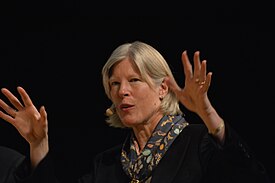Cynthia Kenyon
Cynthia Kenyon | |
|---|---|
 | |
| Born | February 21, 1954 |
| Alma mater | Massachusetts Institute of Technology |
| Known for | Aging in C. elegans |
| Awards | National Academy of Sciences Dan David Prize |
| Scientific career | |
| Fields | Biologist |
| Institutions | University of California, San Francisco (UCSF) |
| Doctoral advisor | Graham Walker |
| Notable students | Andrew Dillin |
Cynthia Jane Kenyon (born February 21, 1954) is an American molecular biologist and geneticist. She does research on the genetics of aging in the model organism Caenorhabditis elegans, which is a roundworm.
Career
[change | change source]Kenyon did postdoctoral studies with Nobel laureate Sydney Brenner at the MRC Laboratory of Molecular Biology in Cambridge, England, studying the development of C. elegans.
Since 1986 she has been at the University of California, San Francisco (UCSF), as the Herbert Boyer Distinguished Professor of Biochemistry and Biophysics, and now as an American Cancer Society professor. She is also Vice President of Aging Research at Calico, a new company focused on health, well-being, and longevity.
Research
[change | change source]Her early work led to the discovery that hox genes, known to pattern the body segments of the fruit fly Drosophila, also pattern the body of C. elegans. These findings showed that hox genes were part of an ancient and fundamental metazoan patterning system.
Michael Klass discovered that lifespan of C. elegans could be altered by mutations, but he believed the effect was due to reduced food consumption (calorie restriction).[1] Later, Thomas Johnson showed that the 65% life extension effect was due to the mutation itself, not calorie restriction.[2]
In 1993, Kenyon discovered that a single gene mutation (daf-2) could double the lifespan of C. elegans and that this could be reversed by a second mutation in daf-16m.[3] This set off an intensive study of the molecular biology of aging. Kenyon's findings led to the discovery that an evolutionarily-conserved hormone signaling system influences aging in other organisms, perhaps also mammals.[3]
The company she founded, Elixir Pharmaceuticals, is trying to make a pill that would slow down the process that makes people age. It would mimic gene manipulation.
Honors
[change | change source]Kenyon has received many honors, including the King Faisal Prize for Medicine, the American Association of Medical Colleges Award for Distinguished Research, the Ilse & Helmut Wachter Award for Exceptional Scientific Achievement, and La Fondation IPSEN Prize, for her findings. She is a member of the U.S. National Academy of Sciences and the American Academy of Arts and Sciences. She is now the director of the Hillblom Center for the Biology of Aging at UCSF. She is also one of featured biologists in the 1995 science documentary Death by Design / The Life and Times of Life and Times.
Personal diet
[change | change source]Kenyon's research prompted her to make personal dietary changes. She stopped eating high glycemic index carbohydrates when she discovered that putting sugar on the worms' food shortened their lifespans.[4]
Kenyon follows a low glycemic index diet similar to the Atkins diet[4] and the South Beach Diet.[5]
No desserts. No sweets. No potatoes. No rice. No bread. No pasta. When I say ‘no,’ I mean ‘no, or not much,’ she notes. Instead, eat green vegetables. Eat the fruits that aren't the sweet fruits, like melon. Bananas? Bananas are a little sweet. Meat? Meat, yes, of course. Avocados. All vegetables. Nuts. Fish. Chicken. That's what I eat. Cheese. Eggs. And one glass of red wine a day.[6]
But the diet is unproven, she cautions, and she's not recommending it for all. Nevertheless, she's pleased with its performance for her. 'I have a fabulous blood profile. My triglyceride level is only 30, and anything below 200 is good.'[6]
You have to eat something, and you just have to make your best judgment. And that's my best judgment. Plus, I feel better. Plus, I'm thin—I weigh what I weighed when I was in college. I feel great —you feel like you're a kid again. It's amazing.[6]
In the past, Kenyon had also briefly experimented with a calorie restriction diet for two days, but couldn't stand the constant hunger.[4]
Related pages
[change | change source]References
[change | change source]- ↑ Klass M.R. 1983 (1983). "A method for the isolation of longevity mutants in the nematode Caenorhabditis elegans and initial results". Mechanisms of Ageing and Development. 22 (3–4): 279–286. doi:10.1016/0047-6374(83)90082-9. PMID 6632998. S2CID 6870538.
{{cite journal}}: CS1 maint: numeric names: authors list (link) - ↑ Friedman, D. B.; Johnson, T. E. (1988). "A mutation in the age-1 gene in Caenorhabditis elegans lengthens life and reduces hermaphrodite fertility" (PDF). Genetics. 118 (1): 75–86. doi:10.1093/genetics/118.1.75. PMC 1203268. PMID 8608934.
- ↑ 3.0 3.1 Kenyon, Cynthia; Chang, Jean; Gensch, Erin; Rudner, Adam; Tabtiang, Ramon (1993). "A C. elegans mutant that lives twice as long as wild type". Nature. 366 (6454): 461–464. doi:10.1038/366461a0. PMID 8247153. S2CID 4332206.
- ↑ 4.0 4.1 4.2 Kingsland J. 2003. "I want to live forever", New Scientist, Issue 2417, October 18.
- ↑ Platoni, K: "Live, fast, die old" Archived 2007-03-11 at the Wayback Machine, East Bay Express, January 18, 2006.
- ↑ 6.0 6.1 6.2 O'Neill B (2004). "In Methuselah's mould". PLOS Biology. 2 (1): e12. doi:10.1371/journal.pbio.0020012. PMC 322746. PMID 14758367.
{{cite journal}}: CS1 maint: unflagged free DOI (link)
Other websites
[change | change source]- NIH Profile: Cynthia Kenyon, Ph.D. Archived 2007-10-19 at the Wayback Machine
- Basic Research: Cynthia Kenyon by Steven Kotler in Discover, vol. 25, no. 11, 2004
- Kenyon Lab at UCSF
- Cynthia Kenyon's seminar: Genes that Control Aging Archived 2013-10-29 at the Wayback Machine
- Cynthia Kenyon: "A GENETIC CONTROL CIRCUIT FOR AGING" Archived 2015-09-12 at the Wayback Machine
- Cynthia Kenyon Seminar: "Longevity Mutants" Archived 2015-06-18 at the Wayback Machine
- Elixir Pharmaceuticals
- Kenyon Lab website
- In Methuselah's Mould, an open-access interview discussing Kenyon's research and her personal low carb diet.